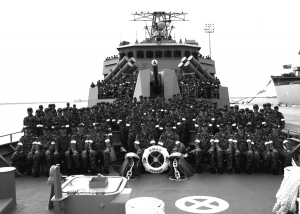- Author
- Editorial Staff
- Subjects
- RAN operations, Ship histories and stories
- Tags
-
- RAN Ships
- HMAS Darwin, HMAS Ballarat II, HMAS Stuart III
- Publication
- December 2011 edition of the Naval Historical Review (all rights reserved)
The preparation for a deployment is a lengthy process and for Stuart’s last deployment involved the additional challenge of Sea Swap. Sea Swap is an alternate crewing model to improve effectiveness and significant financial savings. The concept improves effectiveness and efficiency in the generation of Navy capability by reducing the need to transfer mission-specific equipment across platforms, thereby saving significant costs. In our case, it involved the crews of HMA Ships Stuart and Ballarat swapping platforms.
We recently published an article (NHR March 2011) Three Ships Called Anzac commenting upon the performance of these ships. Could you give us an insight into their capabilities and the preparation for a lengthy deployment?
The current HMAS Stuart is the third of the famous name. An ANZAC Class frigate, her range and armament make this class of ship extremely versatile and therefore suited to multi-faceted operations. The inclusion of a helicopter significantly increases the surveillance range and ASW capability, as well as providing further logistic and boarding options. Depending upon tasking, the ship’s complement varies from between approximately 150 and 192. During the deployment to Operation Slipper Rotation 25, Stuart had 190 personnel onboard. The ‘smaller’ mess decks in an FFH enable versatility in terms of the composition of the crew, specifically the breakdown of males and females. For the last deployment to the MEAO, Stuart’s scheme of complement comprised 158 males and 32 females.

Shortly after changing platforms from Ballarat to Stuart, the ship’s company was required to make numerous preparations, both personal and platform focussed, within a very compressed timeline to ensure that all was ready for a rigorous and demanding collective training period. It became evident from the start that the prime challenge would be the maintenance of a sufficient materiel state in Stuart to ensure that the ship could meet the intense demands of the collective training period, closely followed by a 6 month deployment. Whilst machinery casualties throughout the entirety of the period leading up to and including the date of deployment presented significant challenges, a concerted and intense effort by both ship’s staff and support agencies resulted in Stuart having few materiel issues whilst deployed. The maintenance of a satisfactory materiel state for ships on operational deployment is aided via the assurance of a Self Maintenance Period conducted at approximately the half way mark. This increased period alongside is a significant and smart inclusion, one that I had never experienced in my two previous deployments to the MEAO.
Stuart’s road to operational deployment began in July with the commencement of a period at sea where the ship was left to its own devices to ‘ensure that all preparations to ensure the best position’ for the commencement of the collective training period. Collective training is one of the most intense and demanding periods of any naval service person’s life, with the programme designed to demand the ultimate test of both personnel and platform. The training organisation within Navy and specifically Fleet Command has committed a lot of time and effort to ensuring that both the unit and mission readiness and evaluation periods are structured to ensure that at the culmination of this training, a ship is best postured for mission success.
The hindsight of the knowledge and experiences the ship’s company gained from the operational deployment clearly demonstrates that the training delivered during this preparatory phase is of a high calibre and significantly, is meeting the intended aim of mission success for the ship.
For Stuart collective training commenced with a five and a half week Unit Readiness Workup and Evaluation. The Unit Readiness Workup tests you in every facet of warfare and shipborne life. It was followed by what was initially scheduled to be a two week period alongside designed for defect rectification and preparation for the upcoming Mission Readiness Evaluation. The time alongside blew out to three weeks due to a significant defect on one of the generators that supplies power. The Mission Readiness period was of two weeks duration and as the name suggests, activities throughout this period are focussed towards the upcoming mission. As indicated above, the realism and relevance of this period has improved significantly over the last few years.
Can you give us a feel of how the command and control structure you are operating under while working in the Gulf region works?




